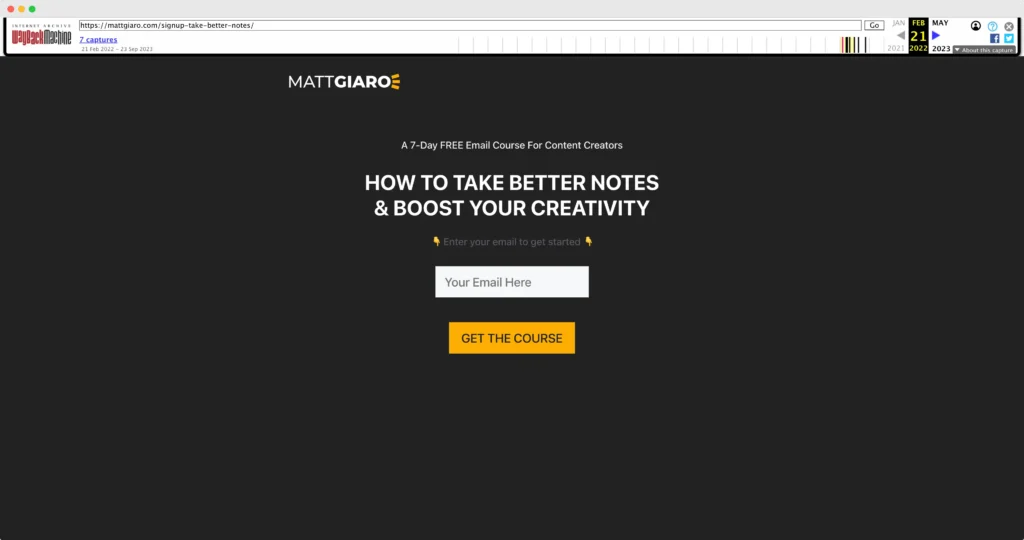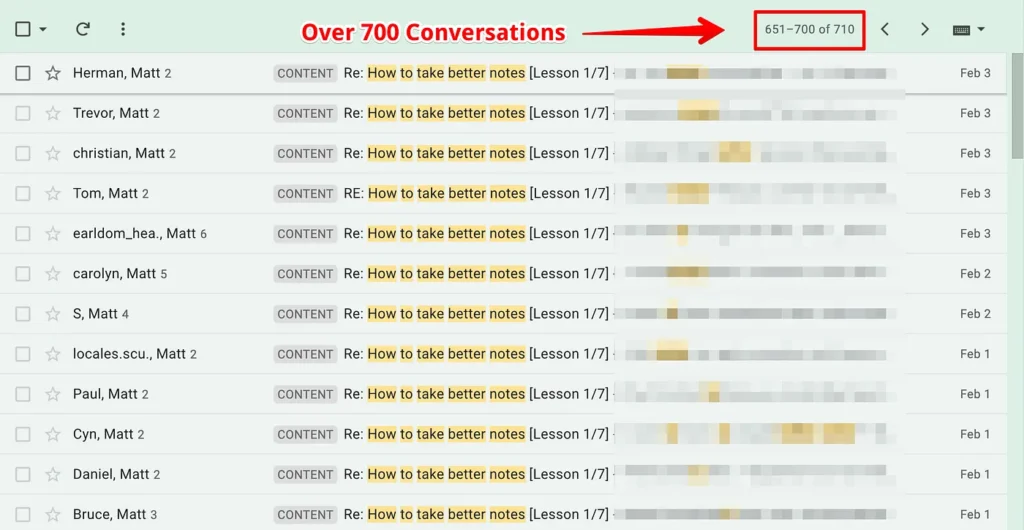In 2022, I launched a note-taking course that made 4-figures in sales in just a few days.
(Today, it’s close crossing 6-figures in total sales.)
Back then, I had no audience, and started from scratch.
Many creators want to sell online courses.
At first glance, it seems to be the best way to make passive income while sleeping. But let me tell you this: The “real world” often doesn’t turn out that pretty.
The truth is that most course creators struggle to sell their online courses.
This is a recurring pattern I’ve experienced in my 10 years in the trenches.
Just because creating an online course doesn’t cost you money, it does not mean that you should jump right into creating one.
A smarter approach is to test your ideas before even creating something.
In startup jargon, you want to create a minimum viable product before allocating more resources.
The good news is that course creators can borrow this concept for their creative practice, too.
In this article, I’m going to show you how to ethically create a Minimum Viable Course so that you can test your course ideas before wasting time on creating something that’s not going to sell.
By the end of this journey, you’ll have more confidence and avoid the emotional roller coaster and the disappointment of doing it the wrong way.
For the sake of this article, I assume that you already know or have a field of expertise that you can monetize.
Excited? Then let’s get started.
Step #1: traffic
Do you want to rely on “Free” organic content? All good. But beware that you’re going to spend time crafting it
Or would you like to spend less time crafting content by running ads? Well, it’s up to you. But let me tell you this:
Traffic is never free.
You’re going to spend either money or time to drive traffic to your content.
So pick your poison.
I’ve spent a fair chunk of money on getting ads to work. Over $8,000 in the past months. And here’s what I found out:
I hated the process of running ads. I couldn’t stand looking at tables and percentages every day.
So guess what? I ditched it.
I would encourage you to find a traffic-generating process that you enjoy. Why? Because you have way more chances to be consistent with something you enjoy rather than something you hate. And remember, creating a business is a marathon, not a sprint.
After realizing that running ads is something I hate, I came up with publishing articles. I like to write, so I had way more odds to succeed in turning my articles into a source of traffic.
I focused on publishing articles on Medium until I saw an “engagement pattern” emerge.
Takeaway: Find the traffic source you enjoy and listen to the market feedback.
Step #2: Piggyback on what works
This stage is all about piggybacking on what worked.
Because let me tell you this: Most of what you’ll do in Step #1 won’t perform well. Only a tiny fraction does. But that’s okay.
Pick your winners, and bury the losers.
Don’t get too emotional about it.
Look at the articles (or ads) that got you some traction, and try to identify a pattern.
Ask yourself these 2 questions:
- What are the articles all about?
- What could be the next logical step to keep the conversation going
This is when you can start creating a landing page where people can sign up.
Here’s what my landing page looked like: (screenshot on the waybackmachine)

In exchange for their email, I suggest you create a free email course.
What I’ve done is I’ve crafted a seven-day email course about the topic that I saw emerge: note-taking.
I knew that I could create a course around it, so I started simply gauging the market temperature. The goal is to make sure that your assumptions and your idea of creating an online course are right before building anything.
It’s all about gathering real market feedback.
I started getting people on my email list and engaged with them. I read every email I got and replied personally to understand their needs better.
Since I only worked with articles that had proven engagement, the replies to my autoresponder emails were flooding in every day.
In the first 30 days, I answered more than 345 emails myself to ensure I got it right:

Yes, it ain’t scalable and far away from passive. But this is how you get things right.
Step #3: Making the sale
At this time, you have gathered enough market feedback.
Now comes the moment of truth.
You have to develop a course idea that will solve the most common problems you’ve identified in step #2. To do this, reverse engineer the process and come up with a method that you can distill in your course.
In my case, people wanted to take better notes. They were tired of amassing notes without value. They wanted to create something out of them.
So I started with the end in mind and reversed engineered the process.
Once I got a rough course outline, I came up with a minimum sales page that simply stated the goal of the program, what problem it will solve and what they’re going to learn in the course.
Always remember that I didn’t create anything yet.
I simply stated that the course would be released at a future date and that this was a pre-sale. And since my goal was to reward people who took early action, I offered a deep discount.
Removing the barriers
There are 2 types of online courses.
On one side, you have the courses that you need to think about carefully before buying (the famous “flagship” courses). You probably also need your significant other’s approval.
On the other, you have courses that you almost buy impulsively without the need to read the sales page 12 times in a row.
The key to validating a course idea is to let people put some skin in the game, i.e., pull out their credit cards.
I don’t trust surveys, opinions, or anything else than an order form to create an online course.
Many course creators don’t want to sell their course for dirt cheap because it took them too much time to create. But that’s not our case. We didn’t create anything at that point in time.
So there’s nothing wrong with going “cheap”.
Plus, always remember that it’s essential to show empathy and make the course purchasing process a “no-brainer.”
Your course has no endorsements, no case studies, and absolutely no social proof.
So don’t waste your time investing endless hours on copywriting — Make the purchase a no-brainer.
In my case, I priced the course outrageously low ($50) and added a 30-day no question asked money-back guarantee so that I could remove all the common objections of not buying the course.
Within the first week, I got 10 sales.
Now that I had proved the concept, I could create the course.
This is a nutshell of how you should start approaching course creation. Don’t start with creating the course. Start with validating an idea, and, once you validate the idea, validate the problems.
The course creation comes last.
Do things in the right order
Patience is the key to succeeding at this.
You may be tempted to create a course before gathering real market feedback. Or to create a landing page or a lead magnet before having proven free pieces of content that work.
I know that because I’ve made these mistakes, too.
So remember that through the whole process:
I didn’t start an email list before being sure having articles that performed well.
I didn’t start creating a sales page for the course unless I gathered real-life problems. I didn’t create the course before making a single sale.
Want to monetize your expertise with digital products?
Get my free course below:

